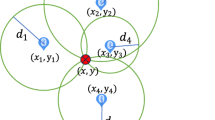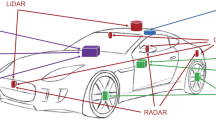Abstract
People localization is required for many novel applications like for instance proactive care for the elders or people suffering degenerative dementia such as Alzheimer’s disease. This paper introduces a new system for people localization in indoor environments. It is based on a topology-based WiFi signal strength fingerprint approach. Accordingly, it is a robust, cheap, ubiquitous and non-intrusive system which does require neither the installation of extra hardware nor prior knowledge about the structure of the environment under consideration. The well-known curse of dimensionality critically emerges when dealing with complex environments. The localization task turns into a high dimensional classification task. Therefore, the core of the proposed framework is a fuzzy rule-based multiclassification system, using standard methodologies for the component classifier generation such as bagging and random subspace, along with fuzzy logic to deal with the huge uncertainty that is characteristic of WiFi signals. Achieved results in two real environments are encouraging, since they clearly overcome those ones provided by the well-known nearest neighbor fingerprint matching algorithm, which is usually considered as a baseline for WiFi localization.







Similar content being viewed by others
Notes
We use the implementation of J48G provided by Weka, a software tool for data mining which is freely available at http://www.cs.waikato.ac.nz/ml/weka/.
References
Alonso JM, Ocaña M, Hernández N, Herranz F, Llamazares A, Sotelo MA, Bergasa LM, Magdalena L (2011) Enhanced WiFi localization system based on soft computing techniques to deal with small-scale variations in wireless sensors. Appl Soft Comput 11(8):4677–4691
Alonso JM, Ocaña M, Sotelo MA, Bergasa LM, Magdalena L (2009) WiFi localization system using fuzzy rule-based classification. Lecture Notes in Computer Science, Comput Aid Syst Theory-EUROCAST09 5717:383–390
Alvarez-Alvarez A, Alonso JM, Trivino G, Hernández N, Herranz F, Llamazares A, Ocaña M (2010) Human activity recognition applying computational intelligence techniques for fusing information related to WiFi positioning and body posture. In: Proceedings of the IEEE international conference on Fuzzy systems, pp 1881–1885
Astrain JJ, Villadangos J, Garitagoitia JR, González de Mendívil JR, Cholvi V (2006) Fuzzy location and tracking on wireless networks. In: Proceedings of the 4th ACM international workshop on mobility management and wireless access, pp 84–91
Bahillo A, Lorenzo RM, Mazuelas S, Fernandez P, Abril EJ (2009) Assessment of the shadow caused by the human body on the personal RF dosimeters reading in multipath environments. In: Biomedical Engineering, pp 133–144
Bahl P, Padmanabhan V (2000) RADAR: an in-building RF-based user location and tracking system. In: Proceedings of the IEEE computer and communications societies, pp 775–784
Banfield RE, Hall LO, Bowyer KW, Kegelmeyer WP (2007) A comparison of decision tree ensemble creation techniques. IEEE Trans Pattern Anal Mach Intell 29(1):173–180
Bonissone PP, Cadenas JM, Garrido MC, Díaz-Valladares RA (2010) A fuzzy random forest. Int J Approx Reason 51(7):729–747
Breiman L (1996) Bagging predictors. Mach Learn 24(2):123–140
Breiman L (2001) Random forests. Mach Learn 45(1):5–32
Chiang KW, Huang YW (2008) An intelligent navigator for seamless INS/GPS integrated land vehicle navigation applications. Appl Soft Comput 8(1):722–733
Cohen WW (1995) Fast effective rule induction. In: Proceedings of the twelfth international conference on machine learning, Morgan Kaufmann, pp 115–123
Cordón O, del Jesus MJ, Herrera F (1999) A proposal on reasoning methods in fuzzy rule-based classification systems. Int J Approx Reason 20:21–45
Cover T, Hart P (1967) Nearest neighbor pattern classification. IEEE Trans Inf Theory 13:21–27
Dharne AG, Lee J, Jayasuriya S (2006) Using fuzzy logic for localization in mobile sensor networks: simulations and experiments. In: Proceedings of the American control conference. IEEE, pp 2066–2071
Dietterich TG (2000) An experimental comparison of three methods for constructing ensembles of decision trees: bagging, boosting, and randomization. Mach Learn 40(2):139–157
Elnahrawy E, Li X, Martin RP (2004) The limits of localization using signal strength: a comparative study. In: First annual IEEE communications society conference on sensor Ad Hoc communications and networks, pp 406–414
Enge P, Misra P (1999) Special issue on GPS: the global positioning system. In: Proceedings of the IEEE, pp 3–172
Gallagher TJ, Li B, Dempster AG, Rizos C (2010) A sector-based campus-wide indoor positioning system. In: IEEE international conference on indoor positioning and indoor navigation, pp 1–8
Garcia-Valverde T, Garcia-Sola A, Gomez-Skarmeta A, Botia JA, Hagras H, Dooley J, Callaghan V (2012) An adaptive learning fuzzy logic system for indoor localisation using Wi-Fi in ambient intelligent environments. In: Proceedings of the IEEE World congress on computational intelligence, pp 25–32
Hernández N, Alonso JM, Magro M, Ocaña M (2012) Hierarchical WiFi localization system. In: international workshop on perception in robotics, IEEE intelligent vehicles symposium, pp P21.1–P21.6
Herrero-Pereza D, Martinez-Barbera H, LeBlanc K, Saffiotti A (2010) Fuzzy uncertainty modeling for grid based localization of mobile robots. Int J Approx Reason 51:912–932
Ho T (1998) The random subspace method for constructing decision forests. IEEE Trans Pattern Anal Mach Intell 20(8):832–844
Hühn JC, Hüllermeier E (2009) FURIA: an algorithm for unordered fuzzy rule induction. Data Min Knowl Disc 19(3):293–319
Kittler J, Hatef M, Duin RPW, Matas J (1998) On combining classifiers. IEEE Trans Pattern Anal Mach Intell 20:226–239
Kuncheva LI (2001) Using measures of similarity and inclusion for multiple classifier fusion by decision templates. Fuzzy Sets Syst 122:401–407
Kuncheva LI (2002) A theoretical study on six classifier fusion strategies. IEEE Trans Pattern Anal Mach Intell 24:281–286
Kuncheva LI (2004) Combining pattern classifiers: methods and algorithms. Wiley, New Jersey
Kuncheva LI, Bezdek JC, Duin RPW (2001) Decision templates for multiple classifier fusion: an experimental comparison. Pattern Recogn Lett 34:299–314
Magdalena L (2008) What is soft computing? revisiting possible answers. In: 8th International FLINS conference on computational intelligence in decision and control, World Scientific, Singapore, pp 3–10
Menendez P, Campomanes C, Trawiński K, Alonso JM (2011) Topology-based indoor localization by means of WiFi fingerprinting with a computational intelligent classifier. In: Proceedings of the 11th IEEE international conference on intelligent system design and applications, pp 1020–1025
Nerguizian C, Belkhous S, Azzouz A, Nerguizian V, Saad M (2004) Mobile robot geolocation with received signal strength (RSS) fingerprinting technique and neural networks. In: IEEE international conference on industrial technology, pp 1183–1185
Optiz D, Maclin R (1999) Popular ensemble methods: an empirical study. J Artif Intell Res 11:169–198
Outemzabet S, Nerguizian C (2008) Accuracy enhancement of an indoor ANN-based fingerprinting location system using Kalman filtering. In: 19th IEEE international symposium on personal, indoor and mobile radio communications, pp 1–5
Outemzabet S, Nerguizian C (2008) Accuracy enhancement of an indoor ANN-based fingerprinting location system using particle filtering and a low-cost sensor. In: IEEE international conference on vehicular technology, pp 2750–2754
Palmer N, Kemp R, Kielmann T, Bal H (2012) The case for smartphones as an urgent computing client platform. Procedia Comput Sci 9:1667–1676
Panov P, Džeroski S (2007) Combining bagging and random subspaces to create better ensembles. In: Proceedings of the 7th international conference on intelligent data analysis. Springer, Berlin, pp 118–129
Paul R, Aguirre E, Garcia-Silvente M, Muñoz-Salinas R (2012) A new fuzzy based algorithm for solving stereo vagueness in detecting and tracking people. Int J Approx Reason 53(4):693–708
Quinlan JR (1991) Improved estimates for the accuracy of small disjuncts. Mach Learn 6(1):93–98
Rodriguez JJ, Kuncheva LI, Alonso CJ (2006) Rotation forest: a new classifier ensemble method. IEEE Trans Pattern Anal Mach Intell 28(10):1619–1630
Schapire R (1990) The strength of weak learnability. Mach Learn 5(2):197–227
Trawiński K, Cordón O, Quirin A (2011) On designing fuzzy rule-based multiclassification systems by combining FURIA with bagging and feature selection. Int J Uncertain Fuzziness Knowl Based Syst 19(4):589–633
Tsymbal A, Pechenizkiy M, Cunningham P (2005) Diversity in search strategies for ensemble feature selection. Inform Fusion 6(1):83–98
Webb GI (1999) Decision tree grafting from the all-tests-but-one partition. In: Sixteenth international joint conference on artificial intelligence. Morgan Kaufmann, pp 702–707
Witten IH, Frank E, Hall MA (2011) Data Mining: practical machine learning tools and techniques. 3rd edn, Morgan Kaufmann, San Francisco
Woods K, Kegelmeyer WP, Bowyer K (1997) Combination of multiple classifiers using local accuracy estimates. IEEE Trans Pattern Anal Mach Intell 19:405–410
Youssef M, Agrawala A (2003) Small-scale compensation for wlan location determination systems. In: Proceedings of the ACM workshop on wireless security, pp 11–20
Yun S, Lee J, Chung W, Kim E, Kim S (2009) A soft computing approach to localization in wireless sensor networks. Expert Syst Appl 36(4):7552–7561
Zhou ZH (2005) Ensembling local learners through multimodal perturbation. IEEE Trans Syst Man Cybern Part B Cybern 35(4):725–735
Acknowledgments
This work has been partly supported by the Spanish Ministry of Economy and Competitiveness under INFANTREE project (JCI-2011-09839), ABSYNTHE project (TIN2011-29824-C02-01 and TIN2011-29824-C02-02), and the European Centre for Soft Computing (ECSC) located at Mieres (Asturias, Spain).
Author information
Authors and Affiliations
Corresponding author
Additional information
Communicated by G. Acampora.
Rights and permissions
About this article
Cite this article
Trawiński, K., Alonso, J.M. & Hernández, N. A multiclassifier approach for topology-based WiFi indoor localization. Soft Comput 17, 1817–1831 (2013). https://doi.org/10.1007/s00500-013-1019-5
Published:
Issue Date:
DOI: https://doi.org/10.1007/s00500-013-1019-5




